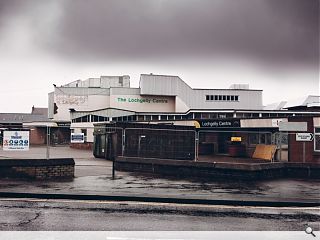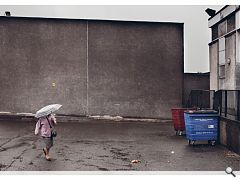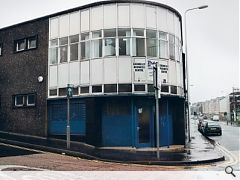Loch-helly
7 Oct 2010
Driving into Lochgelly the first thing that hits you is a large sprawling estate of new build housing, utterly detached from the town proper it lurks behind its own defensive moat of landscaping with a single point of entry acting as a metaphorical drawbridge. It is a sight which Drew Mackie thought paralleled: “the feel of the Home Counties rather than Fife.” It was a depressing, if all too common, introduction to a town which has lost its way, for like others across the Fife region Lochgelly has struggled to adapt to life post coal and unlike its close neighbour Glenrothes, last year’s Carbuncle town, it lacks the critical mass to attract attention of itself and thus feels like a community which has fallen down the back of the couch.
Visiting Lochgelly on a typical July day, an inevitable blanket of low lying cloud was in process of dissipating itself across the landscape at a leisurely deluge, an act of nature which served to put a dampener on our tour but also highlighted the colour blindness of those behind the built environment. Beneath a leaden sky expanses of tarmac and harled buildings seemed to absorb whatever scant light was available to the extent that we seemed to drift through a monotone world constructed entirely from shades of grey. Mark Chalmers recalls this dreich Fife debut: “The light smirr of rain in Glasgow transformed into torrential rain once on the M8 motorway, and although it eased before Lochgelly, the curtain of Fife drizzle soaked into clothes, cameras and folks’ spirits.”Paucity of sunlight apart Chalmers believes the key question the Fife town must answer is whether earlier regeneration efforts will lead to a brighter future. Pointing to the rehabilitation of the former Miner’s Institute and Co-op buildings, alongside the “inevitable” public realm improvements to the centre of town which have created a small public square with a “token” piece of public art, Chalmers noted: “Arguably the money would have been better spent immediately on improving the town’s former civic centre, or cinema, whose Art Deco tower and large auditorium currently lie empty.
It was a public square at the towns heart which elicited most consternation however with Chalmers opining: “The little square lies at the hinge of the High Street yet offers nothing other than domestic scale bounding walls and a couple of seats. Despite the expensive paving and International Socialist-style sculpture, it’s a recessive, negative space which might have been better served by building (or retaining?) a major building here, to assert itself as a piece of townscape.” Mackie concurred: “Although the materials are of reasonable quality, this space is not fully contained and lies below the level of the main street. The obligatory meaningless modern sculpture adds to a feeling of disconnection and I would guess that this may be a favourite outdoor drinking area.” As it is, the Kingdom Housing Association is building business starter units just a couple of doors down – so there is economic activity, and despite the dreich weather, the streets were busy.
If there is one true ‘carbuncle’ in the town it is its former beating heart, the old civic centre, or ‘Lochgelly Centre’, memorably described by Andres Duany as “the biggest piece of shit you’ve ever seen.” Mackie was only somewhat more diplomatic calling it a “visual shock” and “worthy carbuncle”, remarking that it “stamped an alien character upon the town”. Now ensconced behind the sweet poetry of demolition signage, and a Heras fence its days of blight are soon be numbered, despite being built as recently as 1976. But Chalmers points out: “There is still a need for a cohesive social centre to the community, and the functions this relatively young building housed – arts, leisure, entertainment – still need a home. You wonder whether anyone considered adapting, rehabilitating, modernising, applying a new skin with better performance? Demolishing it for the sake of the look of things is a waste, especially in a community without its own cinema, comprehensive sports facilities, or a community hall of a scale to accommodate the whole community.
“It feels like money has been spent in Lochgelly, but on the wrong things – such as the public square, the demolition of the civic centre, and also the charette which Duany participated in, offering housebuilders a "get-out" to develop on the outskirts – when civic facilities should have been provided or upgraded instead, to increase the critical mass of the town centre.”
Mackie adds: “The town has obviously been through hard times since the loss of the coal industry. Its most prominent building, the old Co-op has been converted into housing association flats and this has created a blank facade to what was once a line of shop frontages. The main street turns through a right angle and the incidence of public buildings around this bend suggests that this may have been the centre of the town. Elsewhere a creeping suburbanisation characterises the areas behind the main street, with the occasional public building that hints of former elegance. In sum the parts of the town no longer seem to hang together, its visual approaches are tawdry and recent development does little to restore cohesion.”
Ultimately however dismal Lochgelly may appear its current travails were not in our view sufficient to elevate the town alongside the upper echelons of carbuncle drop outs. Add in a fine stock of Victorian villas on the High Street, excellent rail and motorway links and a natural landscape which boasts excellent vistas of the Fife countryside and the town widely touted as having amongst the lowest average sale prices for housing anywhere in Britain may even come to be seen as something of a bargain.
|
|





